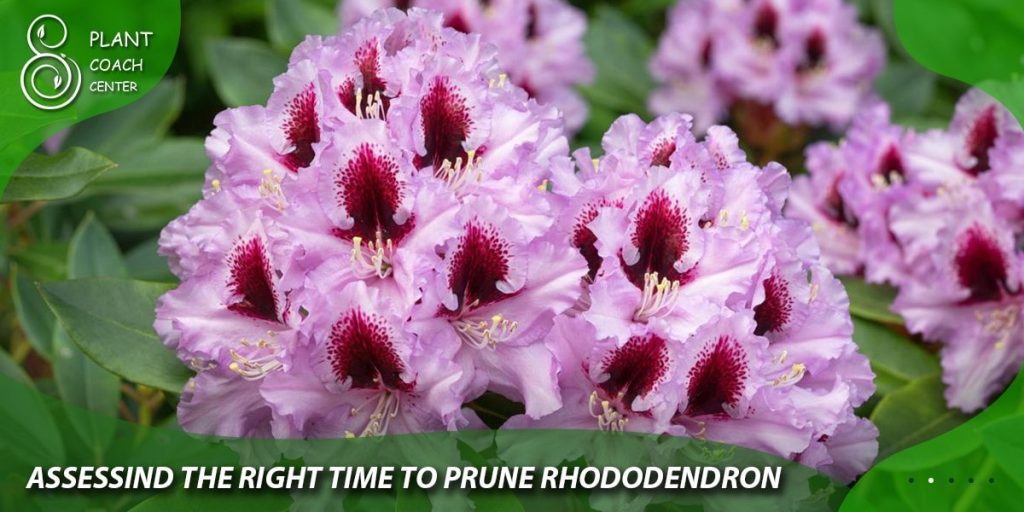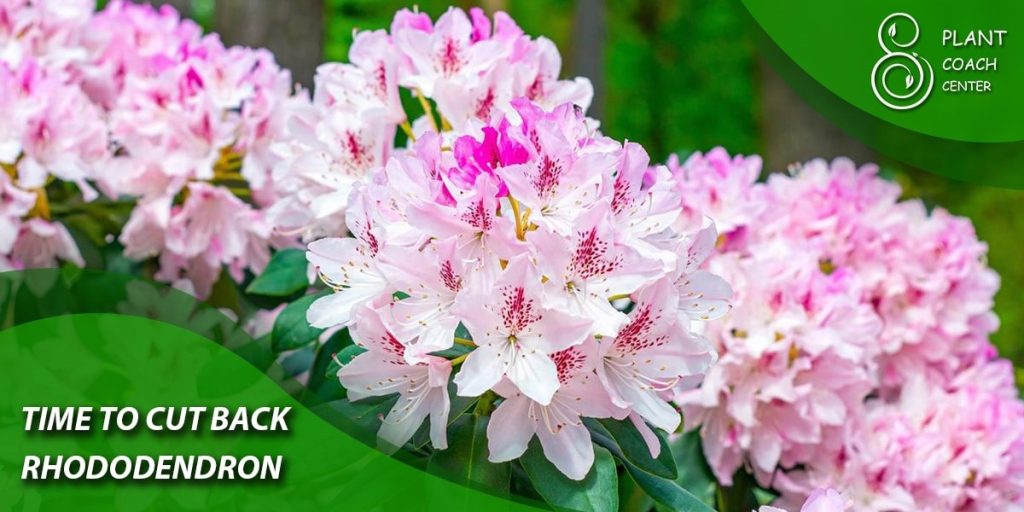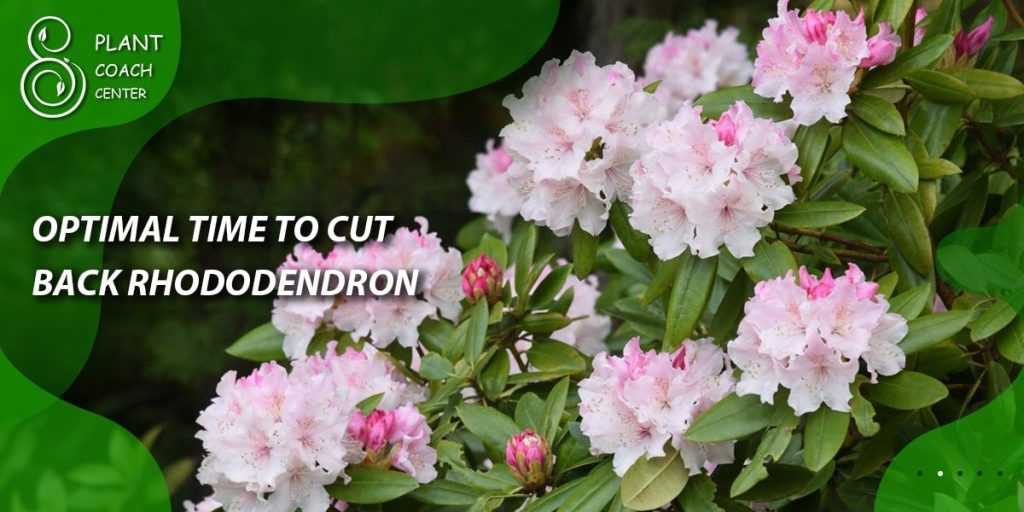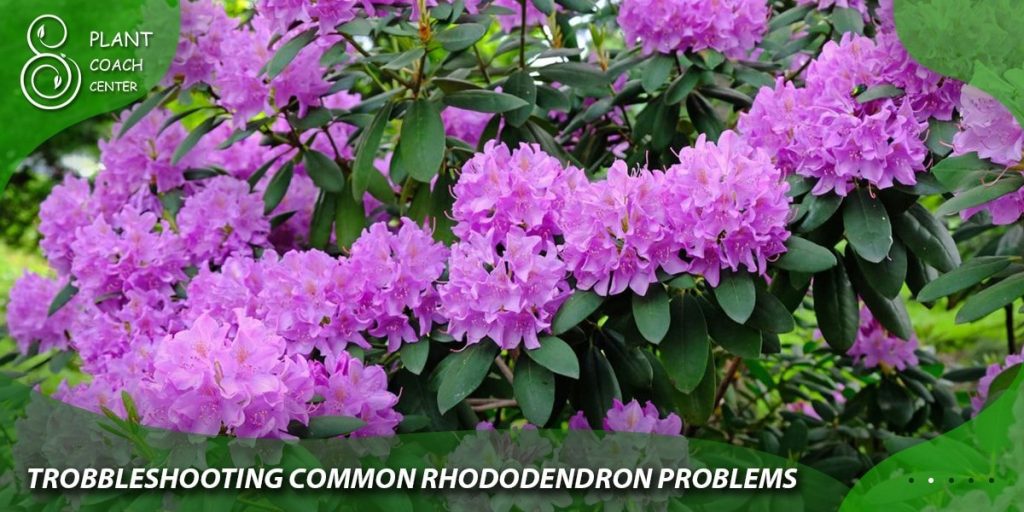When to Cut Back Rhododendron
Rhododendrons are beautiful flowering plants that add vibrancy and elegance to gardens and landscapes. To maintain their health and appearance, it’s essential to understand the proper techniques for pruning and maintenance. This comprehensive guide will delve into the art of pruning rhododendrons, focusing on when to cut them back for optimal growth and blooming. By following these guidelines, you can ensure that your rhododendrons thrive and flourish.

Understanding Rhododendron Growth and Bloom Cycle:
Rhododendrons have distinct growth patterns and stages that dictate their flowering and overall health. These plants typically go through active growth, flowering, and rest phases. Understanding these stages is crucial for determining the appropriate time to prune them.
During the active growth phase in spring and summer, rhododendrons produce new shoots, leaves, and buds. This is a crucial period for the plant’s development, setting the foundation for future blooms.
The flowering phase usually takes place in late spring to early summer, when rhododendrons showcase their stunning blossoms. Pruning during or immediately after this phase can affect the plant’s ability to produce flowers in the following year.
The rest phase occurs in fall and winter when rhododendrons go dormant. This is the ideal time for more extensive pruning, as the plant is less susceptible to stress and can focus on healing and regrowth.
Factors Influencing Growth and Blooming
Several factors can influence the growth and blooming of rhododendrons, including environmental conditions and the plant’s overall health.
- Light and Temperature: Rhododendrons thrive in areas with spotty shade and cool temperatures. Excessive heat or direct sunlight can stress the plant and impact its ability to flower.
- Soil Conditions: These plants prefer acidic soil with good drainage. Improper soil pH or poor drainage can hinder growth and blooming.
- Watering and Moisture: Rhododendrons require consistent moisture. However, excessive watering or waterlogged soil can lead to root rot and other issues.
- Nutrients: Proper nutrition, including the right macronutrients and micronutrients, is essential for rhododendron health and blooming.
Reasons for Pruning Rhododendrons
Pruning is a vital practice for maintaining rhododendrons’ health, shape, and blooming potential. Let’s explore the key reasons why pruning is necessary
Promoting Overall Plant Health and Vigor
Regular pruning helps remove dead, damaged, or diseased branches, which can harbour pests or diseases that negatively impact the plant’s health. By eliminating these compromised parts, you enhance the overall vitality of the rhododendron.
Enhancing Flower Production and Quality
Strategic pruning encourages the growth of new shoots and buds, leading to increased flower production. Selectively removing spent flowers redirect the plant’s energy into developing new blooms, resulting in improved flower quality.
Controlling Size and Shape
Rhododendrons have the potential to grow large and become unruly. Pruning enables you to control their size and shape, ensuring they fit within the designated space in your garden. Maintaining a compact and well-proportioned form can showcase the plant’s beauty while preventing overcrowding.
Removing Damaged, Diseased, or Dead Branches
Pruning helps eliminate branches damaged by weather, pests, or diseases. These branches can be unsightly and pose a risk to the plant’s overall health. Removing them promptly minimizes the spread of diseases and pests and prevents potential hazards such as falling branches.
Improving Air Circulation and Light Penetration
Proper pruning opens the canopy of the rhododendron, allowing for better air circulation and light penetration. This helps prevent the development of fungal diseases and encourages more even growth and flowering throughout the plant.
Now that we understand the importance of pruning, let’s delve into the factors determining the right time to prune rhododendrons.

Assessing the Right Time to Prune Rhododendron
Determining the ideal timing for pruning rhododendrons can significantly impact their growth, flowering, and overall health. It’s crucial to consider the following factors when deciding when to prune:
Understanding the Growth and Blooming Cycles
As discussed, rhododendrons undergo active growth, flowering, and rest phases. Pruning at the wrong time can disrupt these cycles and potentially reduce the plant’s ability to produce flowers in the following year. Therefore, it’s important to be mindful of the specific growth patterns of your rhododendron variety.
Recognizing the Signs Indicating the Need for Pruning
Observing your rhododendron can provide valuable cues for when pruning is necessary. Signs indicating the need for pruning include overcrowding, crossed or rubbing branches, dead or diseased wood, or an undesirable shape. When these issues arise, it’s time to consider pruning.
Considering Regional and Climate-Specific Factors
The appropriate time for pruning can vary based on your location and climate. Rhododendrons in colder regions may benefit from pruning in late winter or early spring to take advantage of the dormant period. In contrast, in milder climates, pruning can be done in late spring or early summer after the blooming phase.
Examining the Impact of Pruning Timing on the Plant
Pruning at different times can affect the growth and blooming potential of rhododendrons. For instance, pruning immediately after flowering may limit flower production the following year. On the other hand, pruning during dormancy allows the plant to allocate its resources toward healing and new growth.
Considering these factors, you can decide when to prune your rhododendrons for maximum benefit. The next section will explore the best practices for pruning rhododendrons to ensure successful outcomes.
Best Practices for Pruning Rhododendrons
Pruning rhododendrons requires careful attention to detail and proper techniques to achieve desirable results. Follow these best practices to ensure successful pruning:
Essential Tools and Equipment
Before you begin pruning, gather the necessary tools and equipment. These typically include sharp bypass pruners, loppers for thicker branches, pruning saws for larger cuts, and clean pruning shears for precision trimming. Ensure that your tools are clean and sharp to make clean cuts and minimize damage to the plant.
Preparing the Plant for Pruning
Inspect your rhododendron before pruning, and remove any dead leaves or debris around the base. This helps prevent the spread of diseases and pests. Clean the pruning tools with a disinfectant to minimize the risk of transferring diseases from one plant to another.
Different Pruning Techniques
There are several pruning techniques you can employ when working with rhododendrons:
- Heading: This technique involves selectively removing a portion of a branch, stimulating new growth. Use heading cuts to control the size and shape of the plant. Make cuts just above a healthy bud or leaf node, angling the cut slightly away from the bud.
- Thinning: Thinning cuts remove entire branches or stems from the rhododendron. Thinning helps improve air circulation and light penetration and reduces overcrowding. Make thinning cuts just above the point of origin, such as a main branch or trunk.
- Rejuvenation: Rejuvenation pruning is more drastic and is used to revive an overgrown or neglected rhododendron. It involves cutting the entire plant about six to 12 inches above the ground. This technique should only be used on healthy, vigorous plants and requires careful post-pruning care.
Proper Cuts and Angles
When making pruning cuts, it’s important to follow proper techniques to promote healing and minimize stress on the plant:
- Use clean, sharp pruning tools to make clean cuts without tearing the bark. Ragged cuts can provide entry points for diseases.
- Make cuts just above a healthy bud or leaf node, ensuring the bud faces outward to encourage outward growth.
- Angle the cuts slightly away from the bud or branch collar to prevent water accumulation and promote healing.
- Avoid leaving stubs, as they can die back and create entry points for diseases.
Dealing with Large or Overgrown Rhododendrons
If you have a large or overgrown rhododendron, it’s essential to approach pruning with caution:
- Assess the plant’s overall health before pruning. Consider more conservative pruning or consult a professional if the plant is weak, stressed, or diseased.
- For large rhododendrons that require rejuvenation, consider a gradual approach. Over several years, prune a portion of the plant each year until the desired size and shape are achieved.
- After pruning, provide proper care, including regular watering, mulching, and fertilization, to support the plant’s recovery and new growth.
By following these best practices, you can ensure that your pruning efforts are effective and promote the health and beauty of your rhododendrons.

Pruning Guidelines for Different Rhododendron Varieties
Different rhododendron varieties may have specific growth habits and characteristics influencing their pruning needs. Consider the following guidelines when pruning common rhododendron varieties:
Compact and Dwarf Rhododendrons
Compact and dwarf varieties typically have a naturally compact growth habit. Minimal pruning is usually required, focusing on removing dead or damaged branches. Light shaping can be done after flowering to maintain the desired form.
Large or Tall Rhododendrons
For larger or taller rhododendron varieties, pruning is often necessary to control their size and shape. Employ thinning cuts to open the canopy, improve air circulation, and maintain an attractive form. Avoid heavy pruning that may compromise their overall health and flowering potential.
Rhododendron Shrubs with Irregular Growth
Some rhododendron shrubs may exhibit irregular growth patterns or develop leggy branches. Pruning should aim to restore a balanced shape and encourage compact growth. Use heading cuts to remove longer branches and redirect growth towards more compact areas of the plant.
Azalea Rhododendrons
Azalea rhododendrons, a popular subgroup, have different pruning needs. The general guidelines for pruning azaleas include the following:
- Removing dead or diseased wood.
- Shaping the plant immediately after flowering.
- Lightly thinning crowded areas to improve air circulation.
Remember, these guidelines are general recommendations, and it’s essential to consider your rhododendron variety’s specific characteristics and growth habits. When in doubt, consult local horticultural experts or arborists for guidance.
Step-by-Step Guide: How to Prune Rhododendron
To ensure you approach pruning your rhododendron with confidence, here’s a step-by-step guide to help you through the process
- Assess the plant: Evaluate the overall health of the rhododendron, identify dead or diseased branches, and determine the desired size and shape.
- Gather the necessary tools: Prepare your pruning tools, including clean and sharp bypass pruners, loppers, and a pruning saw if needed.
- Choose the appropriate time: Consider the growth and blooming cycles of your specific rhododendron variety and regional and climate-specific factors to determine the best time for pruning.
- Start with dead or diseased branches: Remove any dead, damaged, or diseased branches. Make clean cuts just above a healthy bud or leaf node, angling the cut away from the bud.
- Thin-out crowded areas: Identify branches that are crossing or rubbing against each other and those that are growing inward. Use thinning cuts to selectively remove these branches, opening the canopy and improving air circulation.
- Shape the plant: If necessary, shape the rhododendron by making heading cuts to control its size and shape. Take care to maintain a balanced form and avoid excessive pruning.
- Step back and evaluate: Regularly assess the plant’s appearance during pruning. This allows you to maintain a natural and aesthetically pleasing shape.
- Clean up and post-pruning care: Remove all pruning debris around the plant to reduce disease risk. After pruning, provide appropriate post-pruning care, such as watering, mulching, and fertilizing, to support new growth and overall plant health.

Common Mistakes to Avoid When Pruning Rhododendrons
Pruning rhododendrons requires precision and care to avoid common mistakes that can harm the plant’s health and appearance. Be mindful of the following pitfalls:
Over-Pruning or Under-Pruning
Over-pruning involves removing excessive foliage or branches, weakening the plant and hindering its photosynthesis. On the other hand, under-pruning can lead to overcrowding, reduced air circulation, and limited flower production. Find the right balance by following the appropriate pruning techniques and considering the specific needs of your rhododendron variety.
Improper Timing and Its Consequences
Pruning at the wrong time can disrupt rhododendrons’ growth and blooming cycles. Pruning immediately after flowering may remove potential flower buds for the following year. Late pruning can result in reduced flower production in the current year. Refer to the earlier section on assessing the right time to prune and follow the specific guidelines for your rhododendron variety.
Neglecting Necessary Safety Precautions
When pruning, it’s crucial to prioritize safety. Wear appropriate protective gear such as gloves, safety glasses, and sturdy clothing. Use tools correctly and mindfully to prevent accidents or injuries. If pruning large or tall rhododendrons, consider employing the assistance of a professional arborist to ensure safety.
Negligence in Post-Pruning Care
Proper post-pruning care is essential to support the rhododendron’s recovery and promote new growth. After pruning, water the plant thoroughly, ensuring the soil is moist but not soggy. Apply a layer of organic mulch around the base of the plant to conserve moisture and suppress weed growth. Additionally, consider providing a balanced fertilizer for rhododendrons to support healthy regrowth.
By avoiding these common mistakes, you can optimize the benefits of pruning and maintain the health and beauty of your rhododendrons.
Troubleshooting Common Rhododendron Problems:
While pruning helps promote the health of rhododendrons, it’s important to address any underlying problems that may affect their growth and blooming. Here are some common issues to watch out for:
Identifying and Addressing Diseases and Pests
Rhododendrons can be susceptible to powdery mildew, leaf spot, and root rot. Regularly inspect your plants for signs of disease, including discoloured leaves, wilting, or unusual growth. Consult with local gardening resources or experts to identify the problem and appropriate treatment options if detected.
Dealing with Nutrient Deficiencies or Imbalances
Rhododendrons require specific nutrients for healthy growth and blooming. Nutrient deficiencies or imbalances can manifest as yellowing leaves, stunted growth, or poor flowering. Conduct a soil test to determine the nutrient status and adjust fertilization accordingly. Use a fertilizer specifically formulated for acid-loving plants like rhododendrons.
Recognizing and Managing Environmental Stressors
Rhododendrons can be sensitive to environmental stressors such as excessive heat, drought, or improper lighting. Ensure your plants are situated in suitable locations with dappled shade, well-draining acidic soil, and consistent moisture. Protect from harsh sunlight and extreme temperatures to minimize stress on the plants.
Regular monitoring, proper care, and timely intervention can help address these issues and ensure your rhododendrons’ continued health and vitality.

Conclusion
Pruning rhododendrons is a valuable practice that contributes to these beautiful plants’ overall health, shape, and blooming potential. By understanding the growth and blooming cycles, assessing the right time to prune, following best practices, and avoiding common mistakes, you can confidently care for your rhododendrons.
Remember, each rhododendron variety may have unique needs, so tailor your pruning approach accordingly. Additionally, stay vigilant for any underlying problems and provide appropriate care and treatment as needed.
With proper pruning and care, your rhododendrons will flourish, displaying their vibrant blooms and enhancing your garden’s or landscape’s beauty.
When is the best time to prune rhododendrons?
Prune after flowering or during the dormant season.
How much should I prune my rhododendron?
Avoid excessive pruning; remove dead or diseased branches and thin out overcrowded areas.
Can I rejuvenate an overgrown rhododendron?
Yes, gradually prune over several years, cutting back to 6-12 inches above the ground annually.







